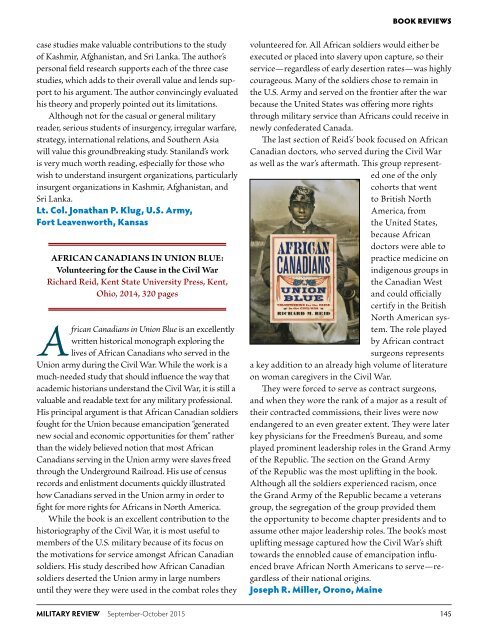Heel
s7u3wR
s7u3wR
Create successful ePaper yourself
Turn your PDF publications into a flip-book with our unique Google optimized e-Paper software.
BOOK REVIEWS<br />
case studies make valuable contributions to the study<br />
of Kashmir, Afghanistan, and Sri Lanka. The author’s<br />
personal field research supports each of the three case<br />
studies, which adds to their overall value and lends support<br />
to his argument. The author convincingly evaluated<br />
his theory and properly pointed out its limitations.<br />
Although not for the casual or general military<br />
reader, serious students of insurgency, irregular warfare,<br />
strategy, international relations, and Southern Asia<br />
will value this groundbreaking study. Staniland’s work<br />
is very much worth reading, especially for those who<br />
wish to understand insurgent organizations, particularly<br />
insurgent organizations in Kashmir, Afghanistan, and<br />
Sri Lanka.<br />
Lt. Col. Jonathan P. Klug, U.S. Army,<br />
Fort Leavenworth, Kansas<br />
AFRICAN CANADIANS IN UNION BLUE:<br />
Volunteering for the Cause in the Civil War<br />
Richard Reid, Kent State University Press, Kent,<br />
Ohio, 2014, 320 pages<br />
African Canadians in Union Blue is an excellently<br />
written historical monograph exploring the<br />
lives of African Canadians who served in the<br />
Union army during the Civil War. While the work is a<br />
much-needed study that should influence the way that<br />
academic historians understand the Civil War, it is still a<br />
valuable and readable text for any military professional.<br />
His principal argument is that African Canadian soldiers<br />
fought for the Union because emancipation “generated<br />
new social and economic opportunities for them” rather<br />
than the widely believed notion that most African<br />
Canadians serving in the Union army were slaves freed<br />
through the Underground Railroad. His use of census<br />
records and enlistment documents quickly illustrated<br />
how Canadians served in the Union army in order to<br />
fight for more rights for Africans in North America.<br />
While the book is an excellent contribution to the<br />
historiography of the Civil War, it is most useful to<br />
members of the U.S. military because of its focus on<br />
the motivations for service amongst African Canadian<br />
soldiers. His study described how African Canadian<br />
soldiers deserted the Union army in large numbers<br />
until they were they were used in the combat roles they<br />
volunteered for. All African soldiers would either be<br />
executed or placed into slavery upon capture, so their<br />
service—regardless of early desertion rates—was highly<br />
courageous. Many of the soldiers chose to remain in<br />
the U.S. Army and served on the frontier after the war<br />
because the United States was offering more rights<br />
through military service than Africans could receive in<br />
newly confederated Canada.<br />
The last section of Reid’s’ book focused on African<br />
Canadian doctors, who served during the Civil War<br />
as well as the war’s aftermath. This group represented<br />
one of the only<br />
cohorts that went<br />
to British North<br />
America, from<br />
the United States,<br />
because African<br />
doctors were able to<br />
practice medicine on<br />
indigenous groups in<br />
the Canadian West<br />
and could officially<br />
certify in the British<br />
North American system.<br />
The role played<br />
by African contract<br />
surgeons represents<br />
a key addition to an already high volume of literature<br />
on woman caregivers in the Civil War.<br />
They were forced to serve as contract surgeons,<br />
and when they wore the rank of a major as a result of<br />
their contracted commissions, their lives were now<br />
endangered to an even greater extent. They were later<br />
key physicians for the Freedmen’s Bureau, and some<br />
played prominent leadership roles in the Grand Army<br />
of the Republic. The section on the Grand Army<br />
of the Republic was the most uplifting in the book.<br />
Although all the soldiers experienced racism, once<br />
the Grand Army of the Republic became a veterans<br />
group, the segregation of the group provided them<br />
the opportunity to become chapter presidents and to<br />
assume other major leadership roles. The book’s most<br />
uplifting message captured how the Civil War’s shift<br />
towards the ennobled cause of emancipation influenced<br />
brave African North Americans to serve—regardless<br />
of their national origins.<br />
Joseph R. Miller, Orono, Maine<br />
MILITARY REVIEW September-October 2015<br />
145


